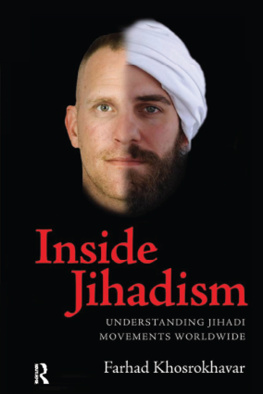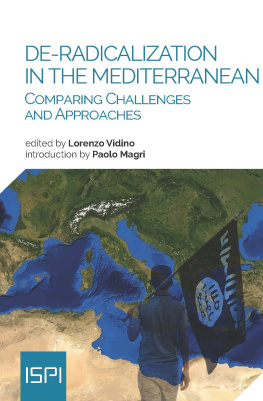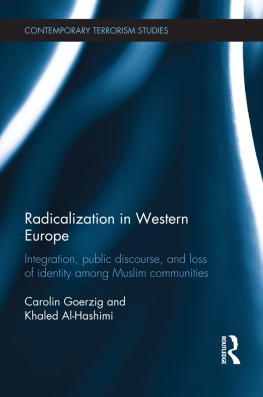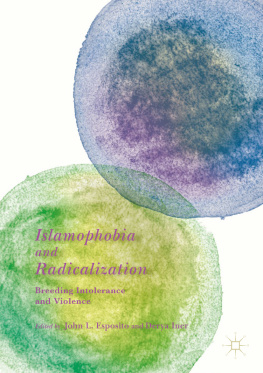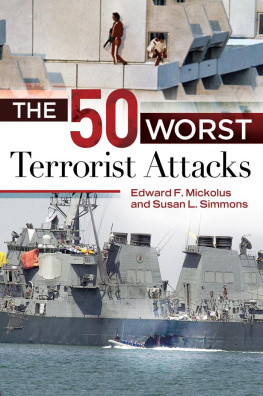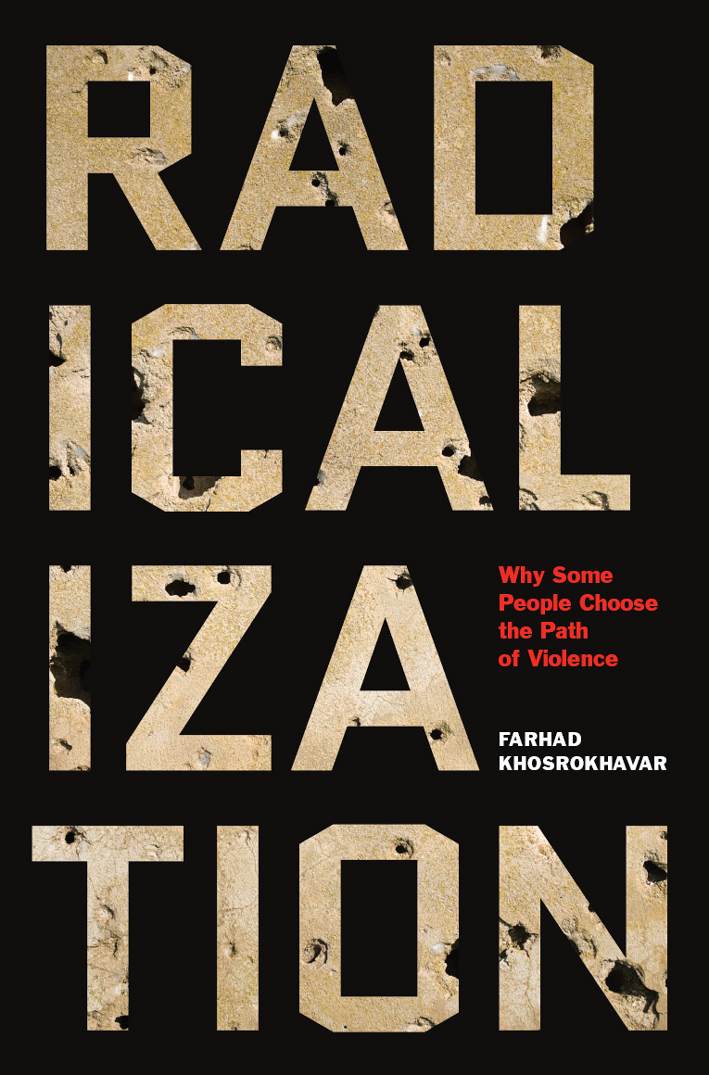

The New Press gratefully acknowledges the Florence Gould Foundation for supporting the publication of this book.
2015 by ditions de la Maison des sciences de lhomme
Translation 2017 by The New Press
All rights reserved.
No part of this book may be reproduced, in any form, without written permission from the publisher.
Requests for permission to reproduce se lections from this book should be mailed to: Permissions Department, The New Press, 120 Wall Street, 31st floor, New York, NY 10005.
Originally published in France as Radicalisation in 2015 by ditions de la Maison des sciences de lhomme, Paris
Published in the United States by The New Press, New York, 2017
Distributed by Perseus Distribution
ISBN 978-1-62097-269-4 (e-book)
CIP data is available
The New Press publishes books that promote and enrich public discussion and understanding of the issues vital to our democracy and to a more equitable world. These books are made possible by the enthusiasm of our readers; the support of a committed group of donors, large and small; the collaboration of our many partners in the in dependent media and the not-for-profit sector; booksellers, who often hand-sell New Press books; librarians; and above all by our authors.
www.thenewpress.com
Composition by Westchester Book Composition
This book was set in Electra
Printed in the United States of America
2 4 6 8 10 9 7 5 3 1
Table of Contents
Guide
Contents
Before the attacks of September 11, 2001, radicalization was a marginal notion, both in the social sciences and in works attempting to make sense of political, religious, or social extremism. In the West, the literature devoted to terrorist movements since the early nineteenth century was more intent on discussing their forms of actionacts of terrorism for some, resistance against the oppressor, the occupier, or the enemy for othersthan on studying the processes leading up to the recourse to violence. Since the September 11 attacks, the United States has attempted to promote research on terrorism and the factors that might encourage it, and radicalization has become a key notion for explaining the genesis of groups that embrace violent action.
The term radicalization refers to the process by which an individual or group adopts a violent form of action directly linked to an extremist ideology with a political, social, or religious content that contests the established order at a political, social, or cultural level (Borum 2011; Wilner and Dubouloz 2010). The elaboration of the practical implications of that notion is, in current practice, undeniably linked to national security concerns and seeks to answer such questions as: How can we protect cities, individuals, and countries (especially those in the West but also, by extension, others) from attack? How can we suppress extremists, especially radical Islamists, in order to reduce (to nothing, if possible) their destructive capacity? How can we fight against terrorist networks both within national borders and internationally? And, since these networks are often transnational, how can we establish connections and cooperate with other countries to put an end to their activities in several places at once? And how can we identify these networks and their leaders so as to be able to neutralize them?
What processes lead individuals to join extremist groups? How can we fight against the appeal of radical ideologies (jihadist Islam in the first place but also violent far-right and far-left views) in societies and, in particular, how do we fight homegrown terrorism, centered not in a foreign country (the Middle East) but in Europe or, less commonly, in the United States, Australia, or Canada?
Another series of questions concerns the profile of those who embark on the path of radicalization: What are the typical profiles of people who become involved in terrorism in its new forms? How do groups constitute themselves, join together, and set in motion a violent action? How do they recruit their members? Who are their sympathizers? And by what criteria do these sympathizers embrace their radical vision, to the point of becoming directly involved in attacks? In short, how do passive sympathizers turn into active terrorists? Finally, how do we deradicalize those who have yielded to the attraction of extremists? In Great Britain, the United States, Norway, and Muslim countries (Saudi Arabia, Algeria, and others), procedures for deradicalization have been devised that combine group therapy, indoctrination sessions by competent authorities (imams for the radical Islamists), and follow-ups by the police and psychologists to direct the former radicals toward nonviolent behaviors.
Governments have called on the academic world, especially in the United Statesbut also, to a lesser degree, in Europe and in the often authoritarian regimes of the Middle East and elsewhereto establish profiles of those with a potential for violent action based on a radical ideology, primarily jihadist Islam. Billions of dollars have been invested, either directly (by the U.S. intelligence services, especially Homeland Security, but also autonomously by cities, such as New York) or indirectly (through research grants), to remedy the lack of information on the subject. Radicalization, once a marginal theme, has become a major one, promoted by the Western nations and, at their impetus, by Muslim states or those affected by them (Singapore, Russia, China, and others), to gather the information necessary to thwart the mass violence perpetrated by small groups.
We have come to speak of a new form of low-intensity war, whose proliferation after the demise of the bipolar world (divided between two major powers, the United States and the Soviet Union), symbolized by the fall of the Berlin Wall in 1989, marked a major shift in the configuration of conflicts. That type of war, waged by guerrillas and by terrorist groups operating in cities who detonate explosive charges in suicide attacks, cannot be combated effectively by traditional armies without profound modifications in their way of doing battle and collecting information.
Since the 1990s, the West has witnessed the appearance of homegrown terrorists, radical Islamists born and raised in Europe or the United States. For example, Khaled Kelkal, who was brought up in France, perpetrated the attack on the RER B rapid transit line at Saint-Michel station in Paris on July 25, 1995, killing 8 and injuring 148. But members of networks from other countries can also find opportunities to spend time in the West, as the members of al-Qaeda who attacked the Twin Towers in New York had done in Germany. For the intelligence services, the task of identifying each of these two types of terrorists raises different problems.
The need for information about these terrorists, homegrown or not, about how and why they embrace ideologies advocating violence, and about the forms of action they take, has in great part made radicalization a key notion for understanding the stages in the formation of terrorists.
A TINY MINORITY
In Western and even Islamic societies, the phenomenon of radicalization affects only a minority, and a tiny one at that. Many may embrace a radical ideology, and many can spiral into violence for economic or social reasons (delinquency, crimes of passion), but few combine the two dimensions and make violence a means of self-expression. Governments do so when they adhere to a supremacist ideology (the superiority of one race or social group over others) or set themselves up as representatives of a privileged class (the working class, in the case of the Soviet Union under Stalin) or of a nation (Hitlers Germany, for example, where National Socialism led to radical nationalism). As I define it, however, the term radicalization does not encompass the state. It includes only movements from below, instigated by individuals or groups advocating an extremist ideology and resorting to violent action. The notion of radicalization has elective affinities with that of terrorism but is distinguished from it in that the focus is on the terrorists motivationson the types of organizations that shape their thinking and which they shape in turn.


